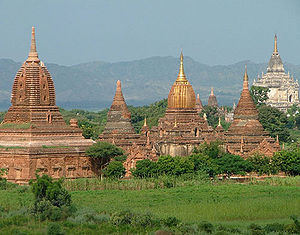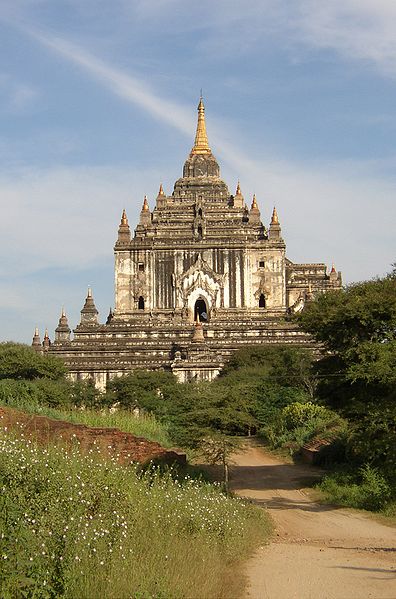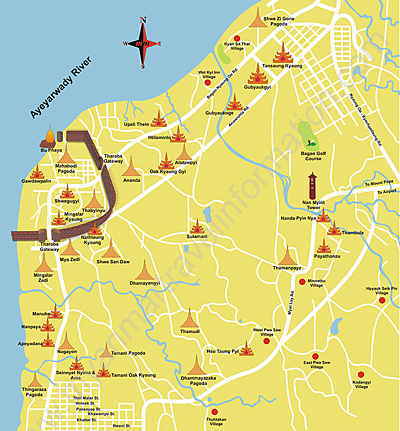 |
|
|
[ Itinerary] [IOld Bagan] [ Burma / Myanmar ] [ 8 minute eclipse ] [ Hotels] [Terms] [ Astrotours 2009 ] [ Astrotours 2010 ]
|
|
 |
|
|
This tour is SOLD OUT - Dec 8, 2009 The fabulous Ruin city of Bagan The ruins of Bagan cover 16 square miles. The majority of its buildings were built in the 1000s to 1200s, during the time Bagan was the capital of the First Burmese Empire. While home to over 2200 lesser stuppas and temples, the site hosts 23 notable different temples. Equal in size and historic reference to Ankor, sprawling across a vast dusty plain, the ruins of Bagan are unhidden. Both sites are notable for their expanse of sacred geography and the number and size of their individual temples. For many visitors Bagan is the more extraordinary of the two cities and this because of the view.
* Ananda Temple. This temple was completed in 1091 A.D. by King Kyanzittha. It is modeled after the legendary Nandamula cave in the Himalaya mountains. Soaring to 51 meters, it received its golden gilding in 1990 in commemeration of the 900th anniversary of its construction. Contained within the temple are four great statues of the Buddhas of the four ages. Kakusandha faces north, Konagamana faces east, Kassapa faces south, and Guatama, the most recent Buddha, faces west. * Gawdawpalin, built in the 12th century by King Narapatisithu, the 60 meter temple was badly damaged in a 1975 earthquake but has been completely reconstructed.
* Shwesandaw, built in 1057 by King Anawahta, the stupa enshrines hairs of the Buddha. It is sometimes called the Ganesh Temple after the elephant headed Hindu god whose images once stood at corners of each of the five terraces.
* Shwezigon, this pagoda was built as the most important reliquary shrine in Bagan. Begun by King Anawrahta and completed by King Kyanzittha in 1089, it contains several bones and hairs of the Buddha. Pilgrims from throughout Burma journey to Shwezigon each year for a great festival during the Burmese month of Nadaw, which falls in the November-December period. This festival is hugely popular because elements of pre-Buddhist Nat worship (Nats are pagan anamistic spirits) were combined with Buddhist themes in the pagoda’s construction. Shwezigon is thus a center of pilgrimage for both the archaic shamanic culture of Burma and the newer religion of Buddhism. |
|
| NOTE ABOUT ETHICAL TOURISM: Astronomical Tours has carefully selected a supplier which will help us support the population of Burma. Our tourism funds will not be paid through the government. Instead, tourism dollars of participants will be routed through the private sector, maintaining the livelihood of the people of Burma in this difficult time. Our advisors on the topic of ethical tourism have confirmed this supplier's position on support and trade with local population. | |
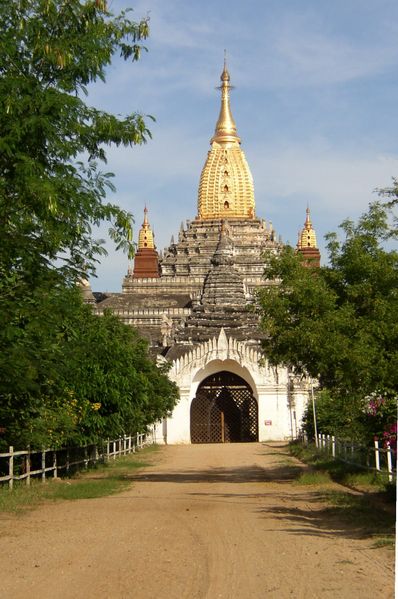 While the kingdoms of Bagan date back to the early 2nd century A.D., Bagan only entered its golden age with the conquest of Thaton by King Anawrahta in 1057 A.D. From this time, until Bagan was overrun by Kublai Khan's forces in 1287 A.D., more than 13,000 temples, pagodas and other religious structures were built. Today, seven centuries later, approximately 2,200 temples remain standing. The river Irrawaddy has washed away nearly one-third of the original city area, thieves have torn apart many temples in search of treasures, while earthquakes and the ravages of time have reduced hundreds of others to great piles of crumbled stones. The photographs illustrate the following temples:
While the kingdoms of Bagan date back to the early 2nd century A.D., Bagan only entered its golden age with the conquest of Thaton by King Anawrahta in 1057 A.D. From this time, until Bagan was overrun by Kublai Khan's forces in 1287 A.D., more than 13,000 temples, pagodas and other religious structures were built. Today, seven centuries later, approximately 2,200 temples remain standing. The river Irrawaddy has washed away nearly one-third of the original city area, thieves have torn apart many temples in search of treasures, while earthquakes and the ravages of time have reduced hundreds of others to great piles of crumbled stones. The photographs illustrate the following temples: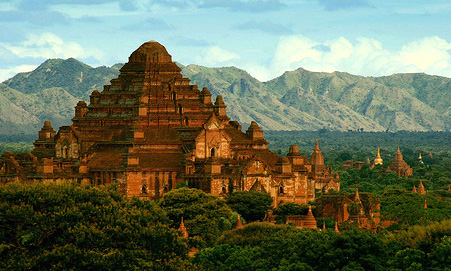 * Dhammayangyi, the largest temple in Bagan, it was built by King Narathu who reigned from 1167 to 1170.
* Dhammayangyi, the largest temple in Bagan, it was built by King Narathu who reigned from 1167 to 1170.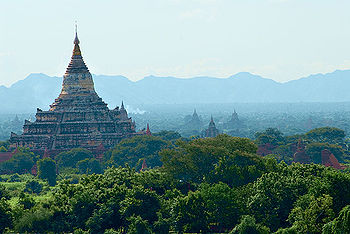 * Mahabodhi, this temple is an exact, though smaller, replica of the famous Bodhi temple in Bodh Gaya, India (where the Buddha attained enlightenment beneath the Bodhi tree). It was built during the reign of King Nantaungmya (1210-1234) and is completely covered with niches containing seated Buddha figures.
* Mahabodhi, this temple is an exact, though smaller, replica of the famous Bodhi temple in Bodh Gaya, India (where the Buddha attained enlightenment beneath the Bodhi tree). It was built during the reign of King Nantaungmya (1210-1234) and is completely covered with niches containing seated Buddha figures. 